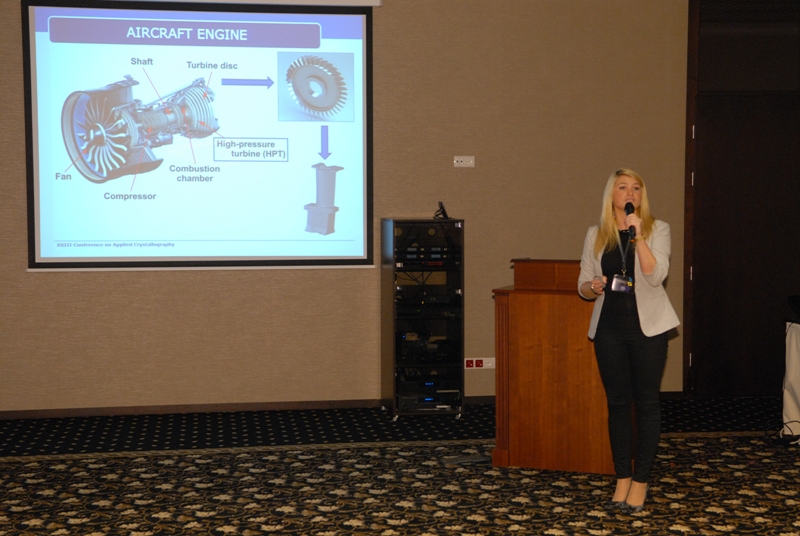The Conference on Applied Crystallography 2015 featured a Young Scientists Session. PhDs were invited to talk about their recent results and works and the best talk of this session was awarded. This year’s winner is Anna Tondos who was also very happy to share some of here experience with the Young Crystallographers from the DGK in this interview.
Anna Tondos did here Bachelor in Materials Engineering at the Silesian University of Katowice, Poland, at the Faculty of Computer Science and Material Science. For her Master in Management and Production Engineering, she changed to the faculty of Materials Engineering and Metallurgy. Her previous research interest is on turbine blades from jet engines. For those who are unfamiliar with modern turbine blades, they are grown from single crystal superalloys, like CMSX-4. Her project focused on the modernization of the uniaxial tensile machine for single crystal materials at elevated temperatures. Anna continued to work in the field of turbine blades. She is currently in her first academic year of her PhD studies and the general topic of her work is “Analysis of the critical areas of single crystal turbine blades of aircraft engines”. Of course this was what her talk was all about.

1) Can you tell us a little bit about the topic of talk?
The topic of my speech was “The influence of selector – root geometry on crystallization of single crystal CMSX-4 turbine blades” [remark: root and selector are parts of the turbine blades which are close to the center]. The turbine blades used in the research were made of CMSX-4, which belongs to second generation of nickel-based superalloys. Those elements are exposed to extreme work conditions, high temperature and aggressive environment. Due to this, the turbine blades tend to create growth defects during service life and manufacturing process. Therefore a single crystal turbine blade reveals a few critical areas. In my presentation I focused on the first area between selectors and root geometry regarding the crystallization process, because defects, which appear on the initial stage, they adversely affected on the whole element. To avoid forming of these defects, research was required to find the reason, place and mechanism of creating them. Going forward I wish to focus on the rest of critical areas.
2) What was the biggest problem of your research project and how did you solve it?
The biggest problem during my work was to learn how to operate equipment for X-ray topography method and then how to interpret the results. Reflective X-ray topography is not a common method in the field of superalloys and results are very difficult to interpret. The proper way of obtaining results and separation of visible effects and defects on topograms require considerable knowledge and experience. Fortunately I have around me a lot of experienced scientists who helped me with analysis results.
3) What fascinates you most about turbine blades?
Turbine blades are very complex elements fully designed to withstand high loads and temperature. The complexity of their design is starting from nano-size particles up to the shape of the overall product. Small changes to any of the blade parameters from chemical composition, manufacturing process or shape can influence the stability and service life of the blades. Also, modern turbine blades have an interesting structure, because they are not strictly a single crystal, they possess two phases and a dendritic structure. However, we are still able to measure them by methods dedicated for single crystal materials.
4) Have you had a special way to prepare your talk? How did you feel before, during and after your talk?
This was my first international presentation, so I want to be very well prepared. After I had prepared all slides, I was writing what I wanted to say on each slide. Then I checked all aspects with my colleagues at the institute. When everything was fine, I was reading it all many times to get more confidence. Additionally, a few days before the conference, I presented my speech on the Institute meeting, where I got some good advice from my colleagues. Regarding to my talk, of course, I felt nervous prior. However, during the presentation my nervousness was passing and I was feeling more comfortable.
5) What was your favorite part of the conference and why?
Of course the awards ceremony J. But seriously, I was very excited to hear the presentation of Nobel Prize Laureate Prof. Dan Shechtman. Additionally, I was very grateful to have had the opportunity to meet a lot of wonderful people from different countries as well.